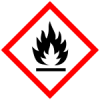Coalition status
Details
Toxicty
GHS safety labels
- H225

Highly flammable liquid and vapour
Class: Flammable
Subclass: Liquids - H301

Toxic if swallowed
Class: Acute Toxicity
Subclass: Oral - H317

May cause an allergic skin reaction
Class: Sensitization
Subclass: Skin - H319

Causes serious eye irritation
Class: (Corrosion)Damage/irritation
Subclass: Eye - H331

Toxic if inhaled
Class: Acute Toxicity
Subclass: Inhalation - H336

May cause drowsiness or dizziness
Class: STOT-CNS
Subclass: Single exposure - H370

Causes damage to organs (or state all organs affected, if known) (state route of exposure if it is conclusively proven that no other routes of exposure cause the hazard)
Class: STOT
Subclass: Single exposure - H400

Very toxic to aquatic life
Class: Aquatic
Subclass: Acute - H410

Very toxic to aquatic life with long lasting effects
Class: Aquatic
Subclass: Chronic
